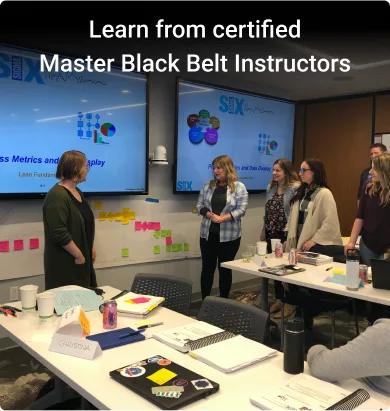Understanding the Basics – Lean Process Improvement
If we are to understand the basics of Lean process improvement let’s start with a review of the definition of Lean. We can define Lean as a system for developing process improvement that is continuous and has a focus on reducing and eliminating waste.
Toyota developed the concept to help with their production operation and improve processes to cut the time it takes from receiving an order to delivering it.
• You minimize waste when you use a Lean approach.
• You look at value from the customer’s point of view and deliver what the customer needs when they need it.
Check our Lean Introduction Training Program
When you implement a Lean Process Improvement approach an organization can:
• Minimize waste
• Reduce inventory
• Increase productivity
• Improve quality
• Increase customer satisfaction
• Reduce costs
• Increase profits
Lean Process Improvement can apply to production environments but also extend to other environments such as healthcare, software development, service, and government.
The ideal with Lean is to meet customer expectations by creating a near-perfect process. The process minimizes waste, uses as few resources as possible, and encourages continuous improvement – principles also central to Six Sigma certification programs, which equip professionals with tools to sustain these gains long-term.
Some basics of Lean Processes:
To accomplish ideal Lean processes, here are some of the techniques:
• look at the overall flow of products and services
• do not focus only on separate technologies and departments but look at the big picture
• look at all assets, technologies, and departments involved
• eliminate waste along the entire process, not just separate points
Compared to a traditional approach a Lean approach, often enhanced by methodologies learned through Six Sigma certification, can use less space, less money, and less time to make products and deliver services. For example, instead of keeping a large inventory of products, you have the inventory you need for your immediate orders. This approach can help you streamline your operations plus respond as customer preferences change.
Some misconceptions:
Lean is not just a way to reduce costs. Instead, it is a way of thinking. It is not a short-term solution. It is the way a group operates. It is actually a long-term approach that requires discipline.
Lean is not just for manufacturing. Groups outside of manufacturing have used a Lean approach and had good results. This can include service groups, healthcare, and government.
While Lean focuses on waste reduction, pairing it with a Six Sigma certification — which targets variation and defects — creates a comprehensive approach applicable across industries like healthcare, IT, and government.
Check our Lean Transformation Programs– Six Sigma
A short history of Lean Process Improvement:
The term Lean appeared in the 1980s to describe an approach Toyota was taking. Dr. Jim Womack of MIT and his team coined the term. Womack and Jones wrote Lean Thinking where they described the basics of Lean organizations and the characteristics of their supply chain.
Womack founded the Lean Enterprise Institute while Jones founded the Lean Enterprise Academy. Their book describes the thinking that should accompany a Lean operation.
[INFOGRAPHIC] 5 Key Principles of Lean Manufacturing or Lean Thinking
The basics of Lean thinking:
Lean thinking should involve purpose, people, and process. With purpose, we should ask – what customer problems will your organization solve and then prosper?
Concerning the process, we should ask how a group will look at each value stream. Each stream should be valuable and adequate. Each step should be linked to flow.
Concerning people, we should ask how a group can be sure that an individual is responsible for evaluating every process. Everyone should be thinking about constant improvement. We should look all the time at the Lean process and business results. Everyone should be actively involved.
Teams committed to continuous improvement often pursue credentials like Six Sigma Green Belt certification to systematize their problem-solving efforts.
Check our Lean Fundamentals Training Program
Some more basics of Lean Process Improvement:
Here are some techniques to help with the Lean vision:
• Pick a specific process or problem to improve
• Put someone in charge of the project
• Put together a team that understands and works on the related process, not just managers
• Make communication a top priority
Lean process improvement
The lean process improvement is defined as a process of self improvisation. But, in theory, the process is a complex and challenging practice. The entire process is identifying opportunities for improvement, implementing changes, and measuring those impacted changes.
It’s a continuous improvement cycle that:
- Identifies opportunities in the process workflow.
- Plans how the current process can be improved.
- Executes changes in the derived implementations.
- Reviews how the new process is working for the team.
Here is a way to look at Lean through phases.
1. Define – This is where you determine your goal.
2. Measure – This is where you are specific about the data you will look at
3. Analyze – Here you look at root causes to solve problems and meet your goal, a skill honed through dedicated Root Cause Analysis Training.
4. Generate – Look here at solutions.
5. Implement – Take action with your solution.
6. Control – Make sure you have achieved your goal and keep the solution in place.
So why wait, register today for your Six Sigma requirement. We look forward to seeing you in our upcoming session near you!
Six Sigma training programs are also available online, including Online Six Sigma White Belt, Online Six Sigma Yellow Belt, Online Six Sigma Green Belt, Online Six Sigma Black Belt and many more.
SixSigma.us offers both Live Virtual classes as well as Online Self-Paced training. Most option includes access to the same great Master Black Belt instructors that teach our World Class in-person sessions. Sign-up today!
Virtual Classroom Training Programs Self-Paced Online Training Programs







